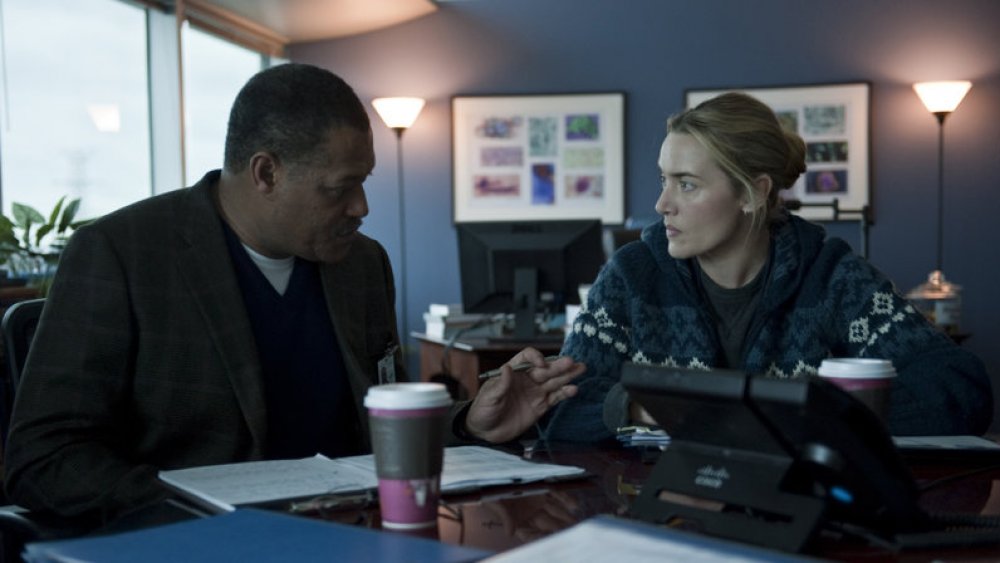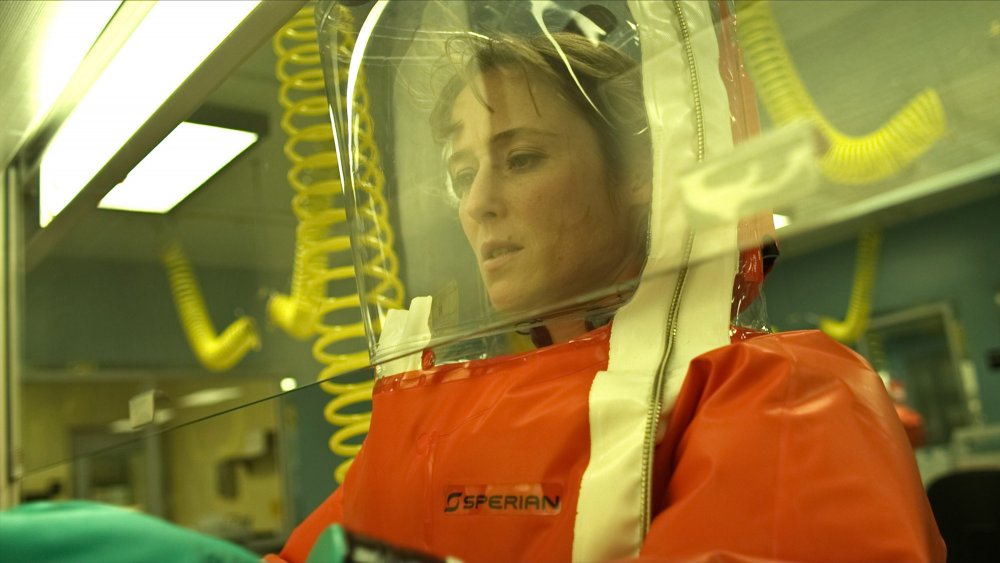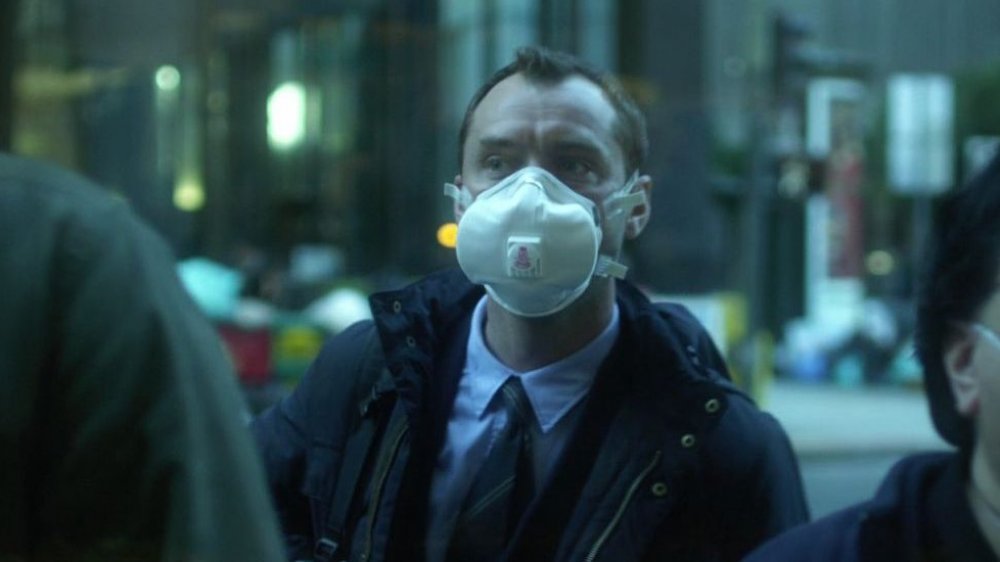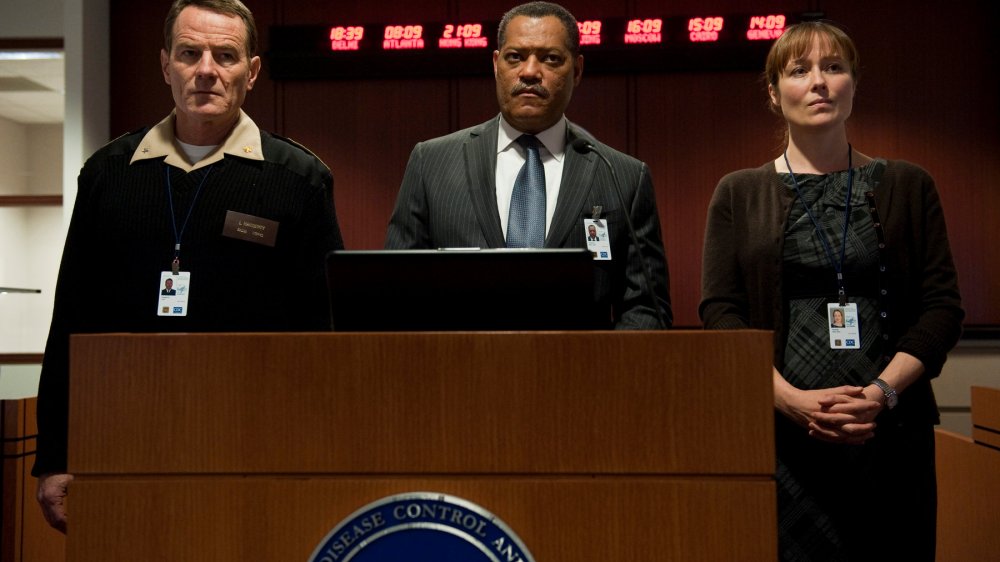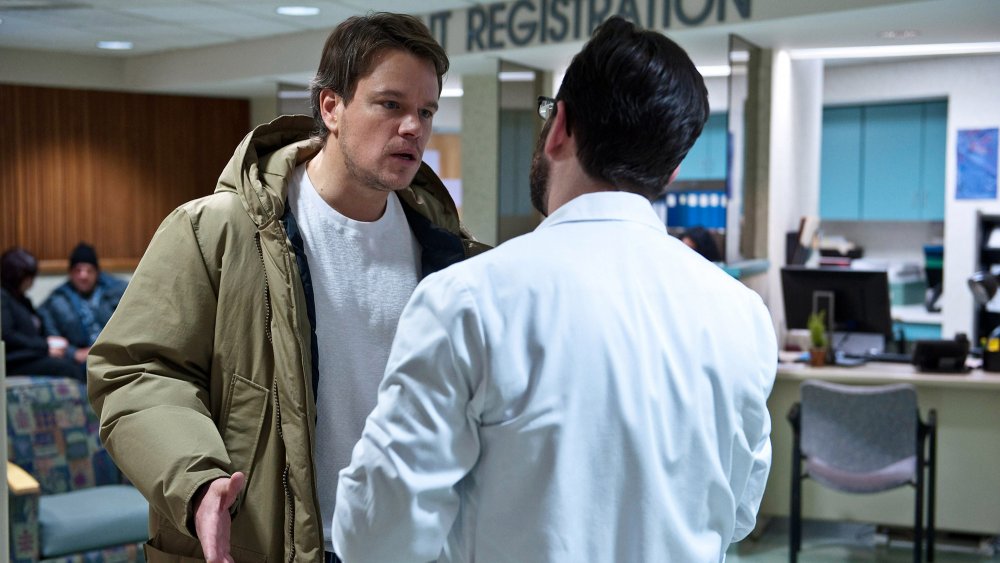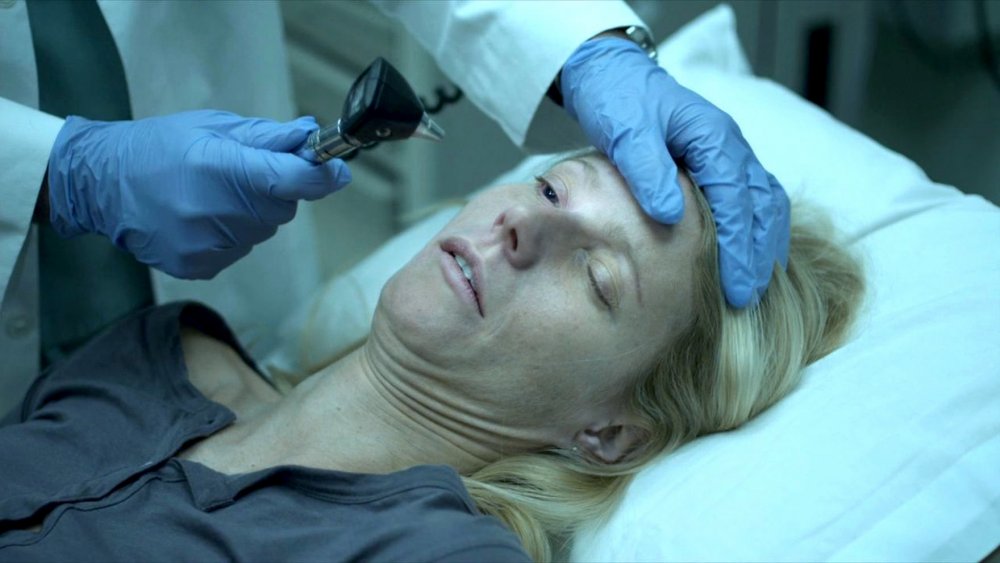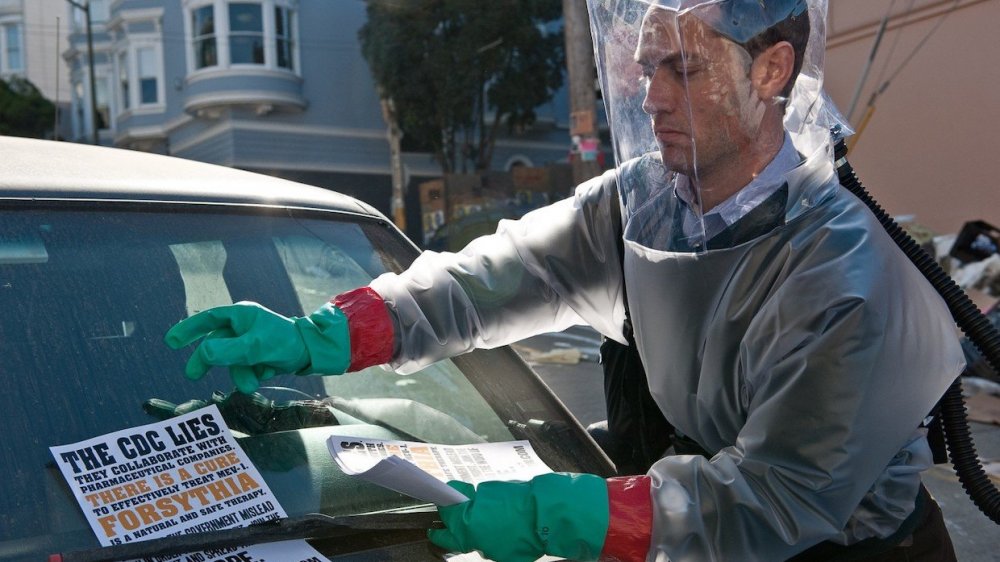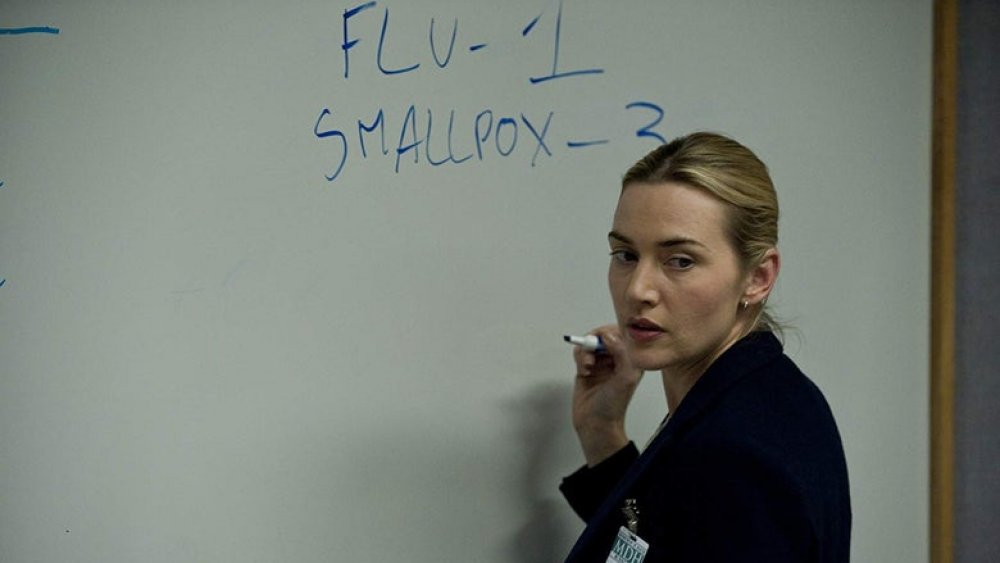The Untold Truth Of Contagion
Steven Soderbergh's star-studded Contagion is a horrific thrill ride. After Beth Emhoff, an American woman, is infected on a business trip, she unwittingly spreads a deadly virus throughout the world. Contagion follows the illness as it rips the globe apart — and as scientists, doctors, and policymakers work to stop it in its tracks.
Starring Matt Damon, Kate Winslet, Laurence Fishburne, and many more A-list actors, Contagion waits until its final five minutes to show us how the virus came to be transmitted to a human in the first place. It was, in fact, through a banal series of events: The pandemic began with deforestation and an escaping bat eating a banana. The bat drops part of the contaminated banana into a slaughterhouse, where a pig eats it. The pig ends up on the menu of a fancy restaurant, where the famous chef doesn't wash his hands after stuffing herbs into the raw pig's mouth. He goes on to a meet-and-greet in the crowded hotel restaurant, where he meets and infects Beth Emhoff. This simple act plunges the world into chaos — and makes Contagion a fascinating film.
The real science behind Contagion
Though a virus jumping from one species to another might seem like science fiction, this is actually science fact. Talking to NPR, Georgetown University's director of the Center for Global Health Science and Security Rebecca Katz remarked, "I show the last few minutes of Contagion to my class, to show the interconnectedness between animals, the environment, and humans." It is deforestation that causes the bat migration in the movie — and thus, causes the pandemic. Moreover, Contagion's virus is spread by "fomites," the scientific name for inanimate objects capable of spreading disease.
Contagion also accurately utilizes the term "R-naught" which indicates the rate of infection based on how much contact the first human carrier has had with others. The professionalism and tirelessness of healthcare workers, evidenced in Contagion by Dr. Erin Mears, is also accurate — as is her later infection, as it is those on the front lines most exposed to disease. The CDC notes that the movie's portrayal of "tracing" the virus back to its original carriers is also fully accurate. It is also possible, they note, that some people, like Contagion's Mitch Emhoff, sometimes have natural immunity.
What Contagion gets wrong
For all it gets right, Contagion still get certain details wrong. For example, Dr. Ally Hextall develops a vaccine, which she tests on herself. While there have been doctors who have done this, in the case of a virulent pathogen such as the one in Contagion, this scenario is highly improbable. As noted by epidemiologist Theresa Madeline, a vaccine would need to be tested on more than just one person in order to prove its efficacy. Also, it's highly unlikely that a vaccine would be distributed according to birthday.
Moreover, even the most contagious diseases have a much longer incubation and potential mortality period than Contagion demonstrates. In the movie, there are four days between Beth Emhoff's infection and her death. In real life, this would take rather longer — shortening it just creates greater cinematic tension. Beth could have been infected for days, even a week, before manifesting symptoms. This is part of what makes viruses so easy to spread: Someone can be infected but not know it, and go about their business as usual.
An inaccurate non-profit sector
Epidemiologist Larry Madoff has pointed out a rather glaring absence in Contagion: The non-profit and "unofficial" sector's virtual absence. Its only representative in the film, in fact, is shady blogger Alan Krumwiede. Writing for The Atlantic, Madoff remarked, "In real life, this sector includes organizations ranging from Medecins sans Frontieres, HealthMap, Flutrackers, to the news media, parent and provider groups, and others who play important and responsible roles. I direct an organization, the Program for Monitoring Emerging Diseases (ProMED), that detects outbreaks rapidly through careful analysis of unofficial sources and reports them widely and transparently. Our efforts led to the early recognition of the SARS outbreak, ahead of official notifications."
But in Contagion, none of these organizations exist, even in fictionalized form. In real life, these groups are on the front lines of pandemic response. They are how the public learns about the illness, how they keep fed, healthy, and safe from its ravages, and often, how they recover in the wake of the virus' rampage.
The CDC's response
It's not every day that a Hollywood movie prompts actual response from government bodies. But the American Centers for Disease Control took time out to address the Contagion pandemic and what they would do if it actually took place. Their response is surprisingly in line with what happens in the movie.
First, they study the virus in depth to understand how it looks and operates. Assistant Surgeon General and then-director of the CDC's Office of Public Health Preparedness and Response in 2011 told LiveScience, "If you don't know what it is, you can't make a lab test for it, you can't make a treatment for it. Everything hinges on knowing what it is." Second, the contagion must be monitored on the local and international levels, often with cooperation of organizations like the World Health Organization. Third, they figure out where the infection started and the various carriers that have been spreading it around the world. This is where social distancing and quarantines to control the spread come in, sometimes set at a federal government level and other times at the local level, depending on CDC recommendations.
Finally, they work with pharmaceutical companies, as well as the Food and Drug Administration, to develop a vaccine, test it, and then distribute it via healthcare centers. Contagion is very much a case of art imitating life, even though the scenario described is a nightmare one.
A robust government
In Contagion, the virus is most definitely the bad guy as it decimates the global population with cold and quick precision. And because the origin of the virus in the film isn't revealed until the last few horrifying minutes, it's easy to sit and watch the movie wondering if the virus had been weaponized by some faction looking to sow global chaos. You might also be waiting for the inevitable government corruption or ineptitude, a la Chernobyl, to raise its ugly head and get more people killed.
But for once, governments in this post-apocalyptic story — in particular, the American government — end up being the good guys, as they try to quash the virus with a safe vaccine. In grave contrast, the US government's pandemic wing was shuttered back in 2018, and its director Rear Adm. Timothy Zeimer was not replaced. As Contagion writer Scott Z. Burns has argued, this sort of institutional muscle is exactly what is necessary to stop a pandemic in its tracks — and it is, in fact, exactly that response that saves the day in Contagion.
The consultant who helped end smallpox
Contagion's pandemic expert consultant Larry Brilliant is quite well named: He was one of the people behind the eradication of smallpox. Back in 2006, Brilliant gave a TED Talk entitled "My wish: Help me stop pandemics," in which he laid out exactly how the next pandemic would take place — not just in America, but around the world. When the Contagion filmmakers crafted their story, Brilliant's predictions became its basis.
As he detailed, "A billion people would get sick. As many as 165 million people would die. There would be a global recession and depression, and the cost to our economy of $1 to $3 trillion would be far worse for everyone than merely 100 million people dying, because so many more people would lose their jobs and their health care benefits, that the consequences are almost unthinkable."
In more recent comments to Wired Magazine, Brilliant noted that his 2006 prediction is a worst case scenario and in the real world, we aren't quite there yet. But, horrifyingly, Brilliant does not sound 100% hopeful that our situation would end up better than the one he crafted for Contagion.
Real-life parallels to divisive public figures
As patient zero of the infection, Gwyneth Paltrow's Beth Emhoff spreads Contagion's disease around the world. In real life, Paltrow has come regularly under fire for her Goop lifestyle website, which medical professionals claim is peddling dangerous misinformation, as well as fake cures for real ailments.Even more damagingly, a Paltrow/Goop-approved doctor is promoting a number of COVID19 conspiracy theories.
Alan Krumwiede in Contagion is a controversial blogger with a huge, fanatical following who has taken it upon himself to share the "truth" about the illness with his viewers. But in fact, Krumwiede is a sociopathic opportunist looking to use his platform to sell a bunk cure for the virus, which gets even more people killed. It also comes to light that Krumwiede wasn't ever even infected by the virus at all, despite his claims of fighting it off. This amalgam of real-world pundits and hucksters is eerie to watch, and especially strange to see in the same movie as someone like Paltrow. Remember: Goop is not a doctor.
Predictive prowess
Screenwriter Scott Z. Burns has been extremely vocal about Contagion's ongoing popularity. Burns spent almost three years studying epidemiology and viruses with Dr. Larry Brilliant and Dr. Ian Lipkin to better understand how a pandemic takes place, in addition to work with the CDC. Because of this, Burns was not at all surprised when coronavirus started spreading as fast as it did, prompting the resurgence of his movie in global culture.
As Burns told Variety, "Every scientist who I spoke to when I worked on the movie said that exact same thing to me: It's not a matter of 'if,' it's a matter of 'when'." But what has surprised Burns is that the administration overseeing the pandemic response has acted nearly opposite to what Contagion predicted: "I had spent enough time at the CDC to know that there were really dedicated people there, waiting to deal with problems like this. I hadn't contemplated as a screenwriter what would happen in an administration where we defunded public health and defunded pandemic preparedness and defunded science, and then went one step further and discredited health officials who were trying to protect us. That was something, as a screenwriter, I never could have anticipated." Dr. Ian Lipkin has since tested positive for COVID-19.
A movie that should have been taken more seriously
Yes, Contagion is a fictional story about an imaginary deadly virus sweeping across the world to devastating effect. But because so much actual science went into the creation of this science fiction, some of the film's advisors suggest Contagion should have been taken more seriously. Tracey McNamara, the film's veterinary consultant, told BuzzFeed News, "I wish people had paid closer attention to it when the film came out, because it really was a warning to the federal government that this could happen and you need to prepare."
McNamara helped make several scenarios read more realistically in the film. When Dr. Hextall tries the vaccine on herself, she was originally scripted to inject her leg through her trousers, which no scientist in real life would do. The filmmakers adjusted accordingly. She also confirmed many of the other creative choices in the film, especially the line "Mother Nature weaponized it," as well as Dr. Mears' monologue about how many times humans touch their faces in a given day, helping spread diseases like the virus in Contagion. "If people are watching it again, and if federal and state officials are watching it again, I hope they're realizing that the movie was really about what can happen with a novel pandemic threat, and I think people should have taken it much more seriously," McNamara said. Hopefully, her words are heeded.
Contagion's surprisingly realism
Contagion isn't the only pandemic movie around. Outbreak, The Andromeda Strain, The Crazies and other horror movies about the spread of deadly viruses are just as looked to by a curious (and sometimes fearful) public. But Contagion is the most realistic by far, according to CDC ecologist Brian Amman, who spoke in great detail with Wired Magazine.
The worst, according to Amman, is Outbreak, with its highly improbable scenario of virus development and infection and its totally boneheaded depiction of monkey-to-human infection. But it's not only the species-to-species virus transmission that makes Contagion so much more real — it's the various steps taken within the movie to identify, treat, and eventually prevent another outbreak. The Daily Beast did an almost beat-by-beat comparison of Contagion's realistic progression to the absolute fantasy promoted in Outbreak, and the verdict is clear: Contagion gets it right. Heed its warnings: Wash your hands, don't touch your face, and stay informed.

